Bulletin – December 2011 The Growth and Development of the Indonesian Economy
- Download the article 858KB
Abstract
The Indonesian economy has recorded strong growth over the past few decades, and in recent years the firm pace of economic expansion has been accompanied by reduced output volatility and relatively stable inflation. Indonesia's economic performance has been shaped by government policy, the country's endowment of natural resources and its young and growing labour force. Alongside the industrialisation of its economy, Indonesia's trade openness has increased over the past half century. As a near neighbour, Australia has long had significant trade ties with Indonesia.
Economic Developments
Indonesia's economy has expanded strongly over recent decades, notwithstanding the sharp economic contraction that occurred during the 1997-1998 Asian financial crisis (Graph 1 and Table 1). This strong pace of growth has seen Indonesia become an increasingly important part of the global economy. It is now the fourth largest economy in east Asia[1] – after China, Japan and South Korea – and the 15th largest economy in the world on a purchasing power parity (PPP) basis. Furthermore, its share of global output – currently just under 1½ per cent – is expected to continue to rise over the years ahead (Graph 2).
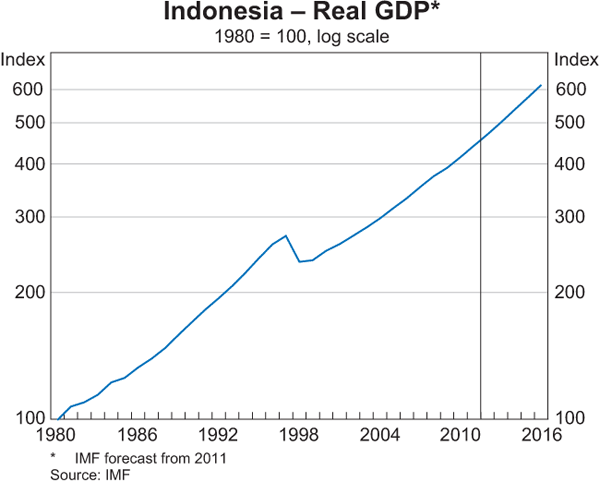
| 1960–67 | 1968–82 | 1983–96 | 1997–99 | 2000–10 | ||
|---|---|---|---|---|---|---|
| Growth(a) | ||||||
| Real GDP per capita | 2.0 | 7.5 | 7.2 | −6.4 | 5.2 | |
| Real GDP per capita | −0.5 | 4.9 | 5.3 | −7.7 | 4.0 | |
| GDP deflator | 291 | 25 | 8 | 34 | 12 | |
| Population | 2.5 | 2.4 | 1.7 | 1.3 | 1.2 | |
| Share of world(b) | ||||||
| GDP(c) | 0.4 | 1.0 | 1.4 | 1.2 | 1.4 | |
| Population | 3.2 | 3.4 | 3.5 | 3.5 | 3.5 | |
|
(a) Average annual rate Sources: IMF; Penn World Table Version 7.0; World Bank |
||||||
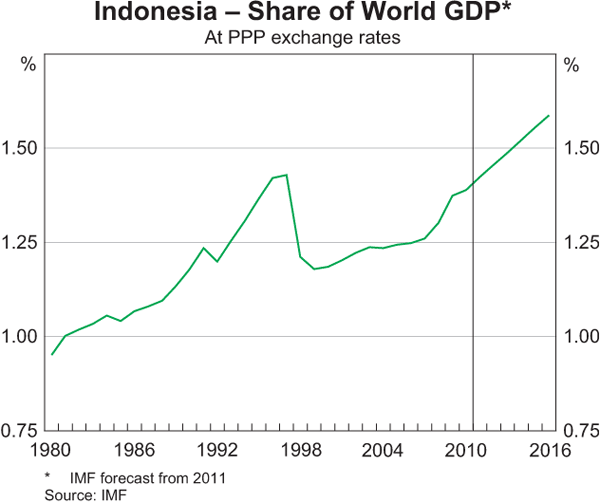
Over time, the structure of the Indonesian economy has changed considerably. Historically, the economy has been heavily weighted towards the agricultural sector,[2] reflecting both its stage of economic development and government policies in the 1950s and 1960s to promote agricultural self-sufficiency. A gradual process of industrialisation and urbanisation began in the late 1960s, and accelerated in the 1980s as falling oil prices saw the Indonesian Government focus on diversifying away from oil exports and towards manufactured exports (Goeltom 2007). From the mid 1980s, trade barriers were reduced and the Indonesian economy became more globally integrated. Since the Asian crisis, Indonesia's relatively strong growth outcomes have been accompanied by reduced output volatility. Notably, economic growth in Indonesia slowed only moderately during the 2008–2009 global downturn, while there was a marked decline in output in most advanced economies and other east Asian economies (except China).
Indonesia is the fourth most populous nation in the world, with 242 million people, and the second most populous in east Asia after China. While Indonesia's population growth has been slowing, in the 2000s it outpaced that in China and the major advanced economies (Graph 3). By 2010, Indonesia accounted for 11 per cent of the population of east Asia and 3½ per cent of the global population. Importantly, Indonesia's population is relatively young. The median age in Indonesia is 28, which is the third youngest in east Asia and around 10 years younger than in most major advanced countries. The dependency ratio – the number of children and elderly relative to the working-age population – is low and the working-age population has been rising. These demographics have provided a boost to GDP growth that should continue for much of the next two decades.[3]
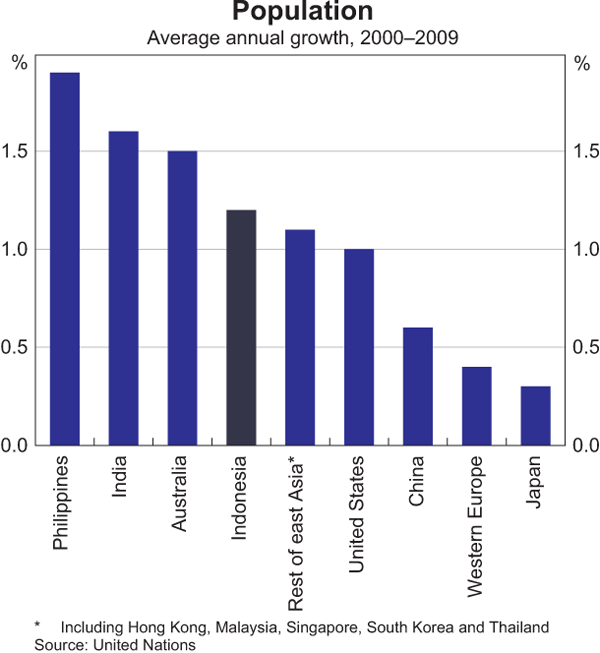
The educational attainment of Indonesia's population has also risen markedly over recent decades. The proportion of primary school-aged children enrolled at school was close to 100 per cent in 2010, up from 70 per cent in 1975, while more than two-thirds of secondary school-aged children were enrolled in school (up from less than 20 per cent 35 years ago). Indonesia is likely to see strong productivity gains from further investment in its human capital, as it will allow more workers to be employed in industries with relatively high value added (Arze del Granado et al 2007).
Indonesia's recent strong economic growth has also been accompanied by relatively steady inflation. This followed a rapid increase in the price level during the Asian crisis driven by the sharp depreciation of the rupiah (Graph 4). Since an inflation target was introduced in Indonesia in 2000, the GDP deflator and the CPI have grown at an average annual pace of 10¾ per cent and 9 per cent, respectively, similar to the pace recorded in the two decades prior to the Asian crisis, but well below the pace in the 1960s and 1970s. Inflation has also generally trended lower through the 2000s, with some of the fluctuations in inflation reflecting government policy initiatives such as the changes in fiscal subsidies in 2005 and 2008 which caused large temporary spikes in CPI growth.
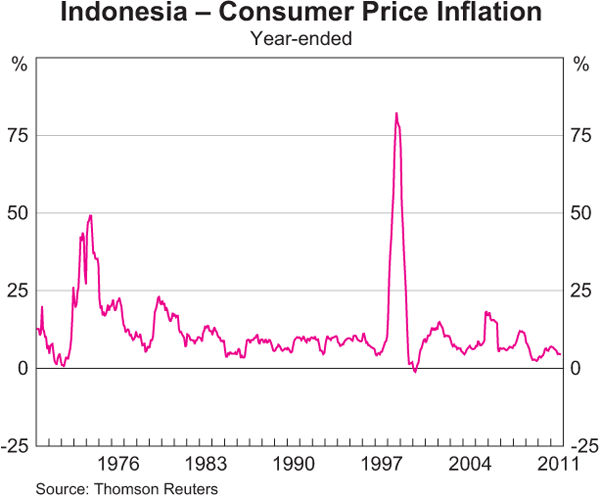
Structure of Production
Like many countries in east Asia, Indonesia has undergone a process of industrialisation and urbanisation over the past 50 years. From 1967 to 2009, the manufacturing share of GDP increased by 19 percentage points while the agricultural share fell by 35 percentage points (Graph 5 and Table 2). Similarly, the share of the population living in urban areas (the urbanisation rate) increased from 17 per cent to 53 per cent over this period (Graph 6). Overall, the pace of urbanisation and industrialisation has been comparable to that experienced elsewhere in the region.
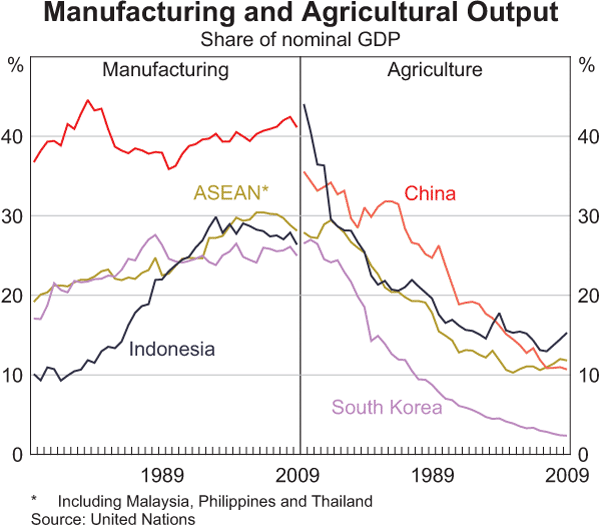
| 1967 | 1982 | 1996 | 1999 | 2009 | |
|---|---|---|---|---|---|
| Agriculture | 51 | 23 | 17 | 20 | 16 |
| Construction | na(a) | 10 | 10 | 8 | 11 |
| Manufacturing | 8 | 13 | 26 | 26 | 27 |
| Mining & utilities | na(a) | 17 | 8 | 9 | 11 |
| Services | 36 | 37 | 40 | 37 | 35 |
|
(a) In 1967 the combined share of construction and mining & utilities was 5 per cent Sources: CEIC; RBA; World Bank; United Nations |
|||||
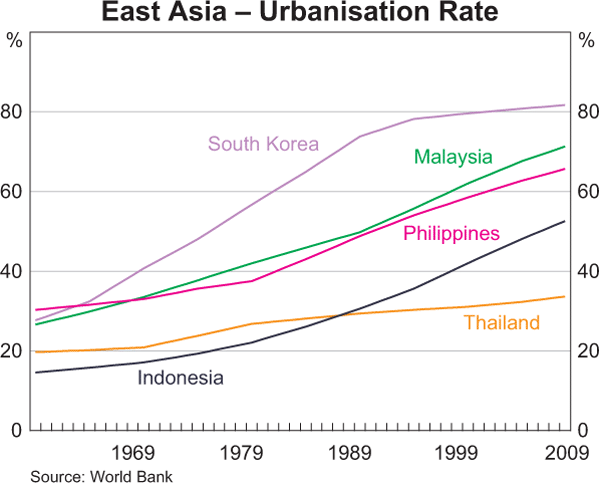
Despite industrialising over the past half century, agriculture remains an important part of the Indonesian economy accounting for 16 per cent of output in 2009 (a relatively high share compared with other economies in east Asia; Graphs 5 and 7). In addition, nearly half of Indonesia's population continue to live in rural areas and, in 2008, agricultural industries accounted for more than 40 per cent of employment – similar to that in China and Thailand, but well above that for Malaysia and Korea.
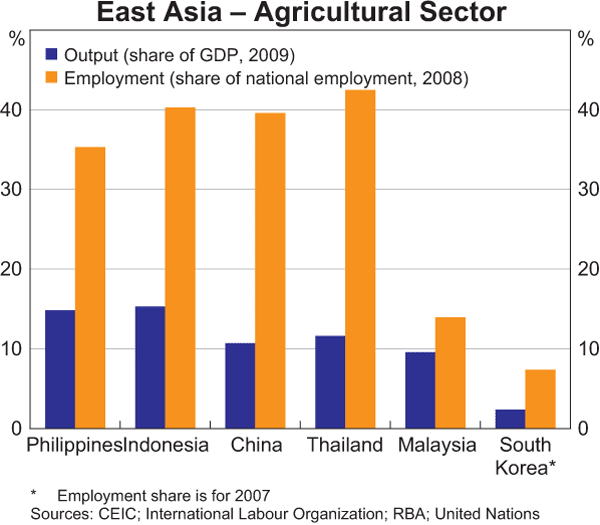
In provinces where employment is highly concentrated in the agricultural sector, incomes are considerably lower than in major urban centres such as Jakarta.[4] In part, this reflects the low labour productivity of parts of Indonesia's agricultural sector. Looking forward, there is considerable scope for productivity in the sector to improve, particularly if modern farming techniques become more widely adopted on Indonesia's outer islands and irrigation systems are improved (ADB, ILO and IDB 2010).
While the manufacturing sector's share of the economy has grown over the
past 50 years – in common with other countries in east Asia – Indonesia's
manufacturing industry has developed differently to manufacturing sectors elsewhere
in the region. In particular, compared with the rest of the region, production
in Indonesia has focused on food, tobacco and textiles rather than elaborately
transformed manufactured goods
(Graph 8).
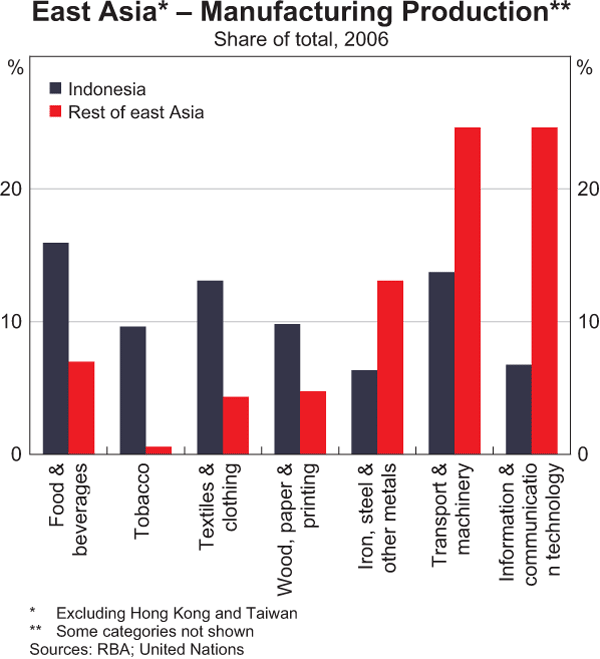
Indonesia has a larger resource sector than many other countries in the region. Mining & utilities output has accounted for around 12 per cent of GDP since the late 1980s, a higher share than in most other east Asian economies and higher than the global average (Graph 9). Oil and gas production accounts for around 40 per cent of Indonesia's mining & utilities output and 1½ per cent of global crude oil and natural gas production. Indonesia is also an important global producer of coal accounting for over 4 per cent of global production in 2010, slightly less than Australia (BP 2011).[5] Indonesia is also a significant producer of a number of other commodities, accounting for 27 per cent of global tin extraction in 2009, 15 per cent of nickel extraction and 6 per cent of copper extraction.
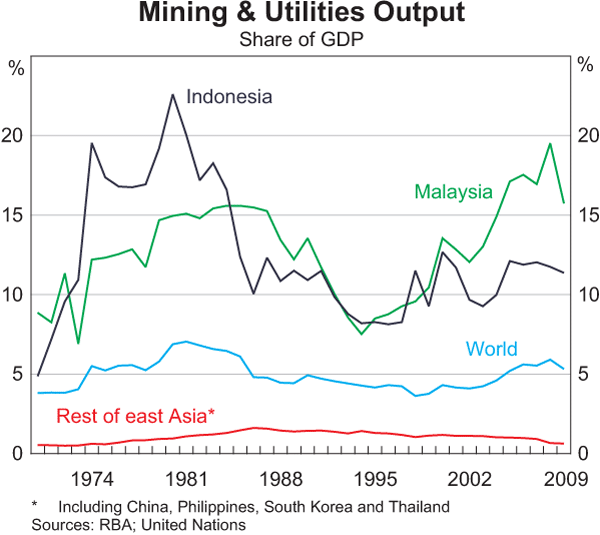
International Trade
Indonesia has become increasingly globally integrated over the past half century, with its ratio of trade to GDP rising from 30 per cent in 1970 to 60 per cent in the 2000s. The value of Indonesia's exports rose rapidly in the early 1970s in line with the first oil price shock. With the world price of oil remaining elevated, oil exports continued to be an important source of revenue for the Indonesian economy through to the early 1980s and Indonesia's trade ratio rose in spite of the government's use of protectionist policies (ADB et al 2010). Falling oil prices in the early 1980s brought on a period of subdued growth in trade values and the government sought to develop non-oil sources of export revenue (Goeltom 2007). By the late 1980s, exports (and imports) had began to rise strongly again as the government pursued policies of trade liberalisation and as the industrialisation of the Indonesian economy accelerated. From this time through to the Asian crisis, Indonesia's trade ratio rose steadily and today the ratio is around its mid 1990s level.
Consistent with these developments, there have been substantial shifts in the composition of Indonesia's exports over the past 50 years (Graph 10). The oil price shocks of the 1970s and early 1980s, and later the industrialisation of the economy, saw agriculture's share of exports decline steadily from 1971 to the early 1990s. Manufacturing exports increased from just 2 per cent of total exports in 1980 to 46 per cent in 1993.
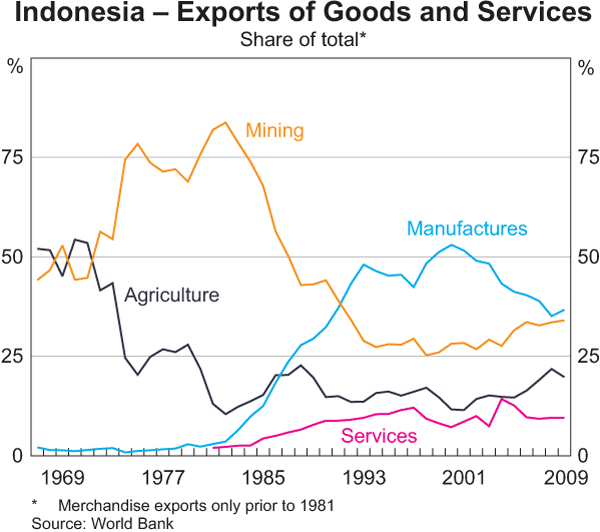
A different set of trends have been seen since the early 1990s. The manufacturing sector's share of exports no longer trended higher (and has more recently been declining) and fuel exports have remained a stable share of total exports. While growth in oil exports has been modest, partly due to fuel subsidises boosting domestic consumption, exports of coal and gas have been rising strongly. After growing at a firm pace through the 1990s, exports of travel services (which comprised more than 90 per cent of service exports until the early 2000s) have been subdued whereas exports of ‘computer, communications & other services’ began to rise rapidly, to account for nearly 40 per cent of all services exports in 2009.
Shifts in the composition of Indonesia's trade have been accompanied by changes in trade destinations. As is the case in other east Asian countries, growth in Indonesia's exports to economies within the region and to developing economies outside of the region has outpaced the rise in exports to major advanced economies (Craig, Elias and Noone 2011; Graph 11). Still, over a third of exports are sent directly to major advanced economies, and a significant proportion of goods exported to economies within the region are intermediate goods that are processed further and, ultimately, used to meet final demand in major advanced economies.[6]
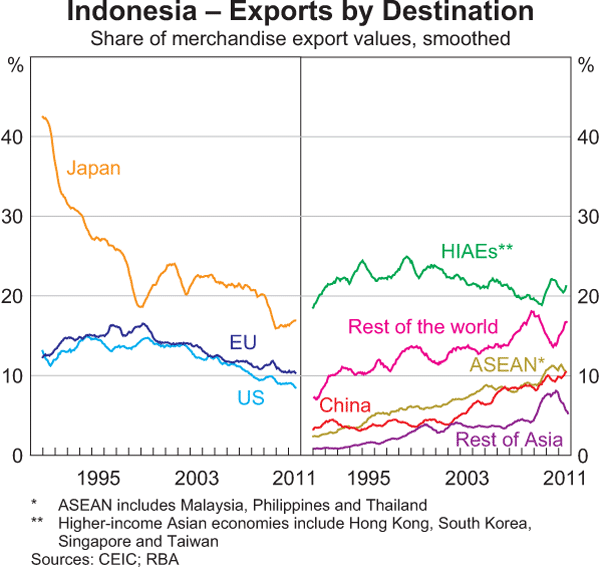
As a near neighbour, Indonesia has longstanding trade ties with Australia and is now Australia's 12th largest trading partner; in 2010, 2 per cent of Australia's exports were sent to Indonesia (by value) and 2.7 per cent of imports came from Indonesia. Over the years ahead, these trade ties are likely to strengthen further as policies negotiated under the ASEAN-Australia-New Zealand Free Trade Agreement come into force. In 2012 Australia will be exempt from 78 per cent of Indonesian tariffs, with this rising to 92 per cent in 2015 (from 11 per cent currently; DFAT (2011)).
Petroleum accounts for almost half of all Australian imports from Indonesia; other major imports include gold, telecommunications equipment and rural goods (Table 3). Cereals are Australia's largest export to Indonesia by value, after having surged by almost 100 per cent per year over the past four years (consistent with the large expansion in Indonesian livestock production). Non-ferrous metals and petroleum are other significant Australian exports to Indonesia.
| Exports to Indonesia | Imports from Indonesia | ||||
|---|---|---|---|---|---|
| Cereals | 1,158 | Petroleum | 3,117 | ||
| Travel services | 899 | Travel services | 1,774 | ||
| Non-ferrous metals | 560 | Gold | 433 | ||
| Petroleum | 299 | Telecommunications equipment | 229 | ||
| Live animals | 291 | Transport services | 188 | ||
| Textile fibres | 247 | Wood | 150 | ||
| Meat | 217 | Metal manufactures | 133 | ||
| Dairy | 161 | Electrical machinery | 118 | ||
| Total | 6,007 | Total | 7,383 | ||
|
Source: ABS |
|||||
Australia and Indonesia also have close links through travel and tourism. More than one in ten tourists to Indonesia in 2010 were of Australian nationality, the third largest share after those of Malaysian and Singaporean nationality. Per person, Australians spent 40 per cent more per visit than the average of all visitors to Indonesia. In the other direction, Indonesians accounted for around 2½ per cent of all short-term visitors to Australia in mid 2011.
In 2010 Indonesia had a modest trade surplus with Australia (of 0.3 per cent of Indonesian GDP or around 10 per cent of total trade between the two countries) and a large aggregate trade surplus (of 3 per cent of Indonesian GDP). Indonesia has had an aggregate trade surplus since 1988 and, with the sharp widening of its surplus on goods trade during the Asian crisis, has recorded current account surpluses in almost every year since 1998.
Domestic Demand
In recent years, Indonesia has seen consistently strong domestic demand growth despite the large shocks to external demand associated with the global economic downturn. As global output contracted by more than 3½ per cent over the three quarters to the March quarter 2009, Indonesian export volumes fell by 20 per cent but domestic final demand rose by 5 per cent with the pace of growth only slowing moderately. This resilience of domestic demand to external influences sets Indonesia apart from its ASEAN peers; over the past 10 years the correlation between domestic final demand and exports was considerably lower in Indonesia than in Malaysia, Thailand and the Philippines. Domestic demand is likely to continue to expand strongly over coming years, supported by an expanding middle class and ambitious government plans to improve infrastructure.
Private consumption expenditure
Household consumption expanded at a strong and stable pace over the past decade, averaging growth of around 5 per cent per year over the 2000s. This was faster than the 4½ per cent average growth reported in the rest of east Asia (excluding the economies of China, Japan and Taiwan), partly reflecting Indonesia's strong population growth. Per capita consumption grew at around 3 per cent per year since 2000, a touch lower than Indonesia's pre-crisis rate of 4 per cent.
Strong consumption growth also reflects rising incomes, with Indonesians moving out of poverty and into the middle class. The share of the population living on less than US$2 per day fell from 91 per cent in 1987 to 51 per cent in 2009 (Graph 12). As this process occurred, consumption of non-food items expanded at a relatively fast pace, growing on average by around 6 per cent in the 2000s, more than double the average growth in food consumption. This resulted in household spending on non-food items rising to be half of total private consumption expenditure by 2009. Based on the experience of other countries, further increases in non-food consumption (relative to total consumption) are likely to occur in Indonesia as incomes rise (Graph 13).
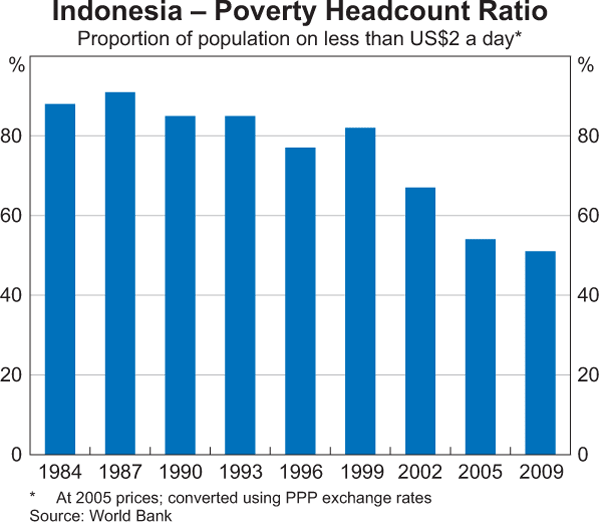
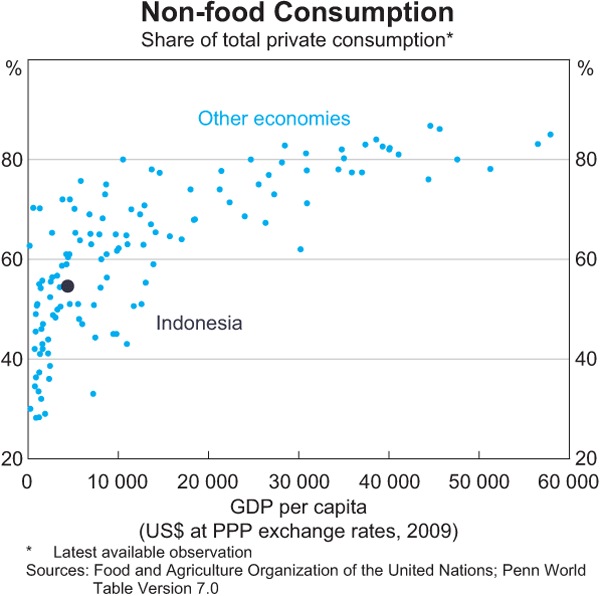
Investment
Strong investment growth is also expected to underpin domestic demand over the next decade, just as it did from the 1960s through to the Asian crisis. Infrastructure investment is expected to be particularly robust, with government plans already in place to substantially improve the current poor state of infrastructure in the country through traditional public works, investment by state-owned enterprises and the encouragement of private investment and public-private partnerships.
The industrialisation of the Indonesian economy saw investment expand at a rapid pace in the late 1960s and the 1970s, averaging around 12 per cent growth per year in real terms. Investment continued to grow at a firm pace over the following decades, increasing to one-third of nominal GDP in the late 1980s (Graph 14 and Table 4). In the wake of the Asian crisis, investment fell to 11 per cent of nominal GDP and Indonesia experienced annual net outflows of foreign direct investment until 2001. Since 2001, investment has expanded by around 7 per cent per annum and its share of nominal GDP has moved back up to 32 per cent.[7]
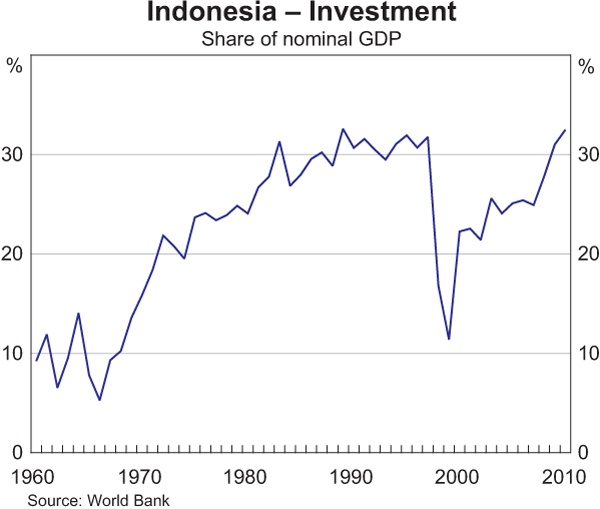
| 1967 | 1983 | 1996 | 1999 | 2010 | ||
|---|---|---|---|---|---|---|
| Final consumption expenditure | 97 | 70 | 70 | 81 | 66 | |
| Gross capital formation | 9 | 31 | 31 | 11 | 32 | |
| Exports | 9 | 26 | 26 | 36 | 25 | |
| Imports | 16 | 28 | 26 | 27 | 23 | |
|
Source: World Bank |
||||||
A rapid outflow of foreign capital contributed to the sharp contraction in investment during the Asian crisis. Between 1997 and 1999, net foreign direct investment in Indonesia shifted from an inflow of 2.2 per cent of GDP to an outflow of 1.3 per cent, while the volume of investment fell by 45 per cent. A number of years of weak investment followed; indeed, only recently has foreign investment recorded strong growth. In 2010, net foreign direct investment inflows increased fourfold to 1.9 per cent of GDP, with the increase broadly based across industries. In addition, the upgrade of Indonesia's sovereign credit rating in 2011 by major credit rating agencies (to be one notch below investment grade) has boosted the attractiveness of Indonesia as an investment destination.
Nevertheless, the poor quality of physical infrastructure in Indonesia continues to be a major impediment to foreign investment. Indonesia is often ranked well below Malaysia and Thailand in global measures of infrastructure quality (Graph 15). Transport infrastructure, in particular, is considered to be a critical problem, with poor quality roads, rail networks, seaports and airports. In addition, a low proportion of the Indonesian population has access to electricity (just 61 per cent in 2007, compared with 97 per cent in Malaysia), and transmission and distribution losses are among the highest in Asia. Moreover, one-third of Indonesia's 44.5 gigawatts of installed generation capacity comprises small-scale units owned by individual firms to ensure adequate electricity supply (ADB et al 2010). The effect that Indonesia's poor infrastructure has on private investment notwithstanding, the quality of infrastructure in Indonesia is broadly in line with what would be expected for its stage of development (Graph 16).
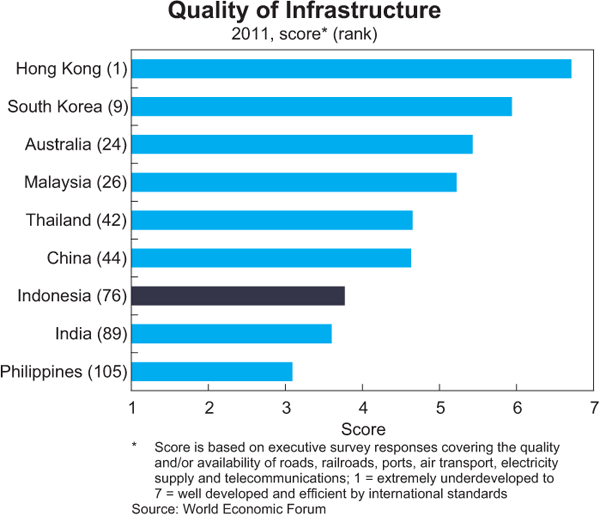

In an effort to improve the quality of infrastructure, in 2010 the Indonesian Government announced a range of infrastructure development targets to be reached by 2014. These included laying 20,000 kilometres of roads, constructing an integrated transport infrastructure network and increasing annual electricity generation capacity by 3,000 megawatts (almost 7 per cent of current capacity; National Development Planning Agency 2010). Consistent with these plans, the government's budget allocation for capital expenditure increased by around 40 per cent in 2011, though the government is expected to face challenges in disbursing these funds (World Bank 2011). Further plans to improve Indonesia's infrastructure and boost potential growth were announced in 2011; this latest plan envisages infrastructure investment worth IDR 1,786 trillion (around US$250 billion) over 2011–2025 to be completed by the government, state-owned enterprises, the private sector and public-private partnerships (Coordinating Ministry for Economic Affairs 2011).
The Indonesian Government has a relatively low debt burden. At 27 per cent of GDP in 2010, the government's gross debt position is well below levels in both the major advanced economies and other east Asian economies (Graph 17). This is a significant turnaround from the late 1990s, when a sharp rise in government debt following the Asian crisis boosted general government gross debt to a peak of almost 100 per cent of GDP, partly reflecting the cost of recapitalising the banking system (de Mello 2008). Despite small budget deficits since then, the debt burden has fallen, reflecting firm economic growth and the sale of assets acquired in the late 1990s.
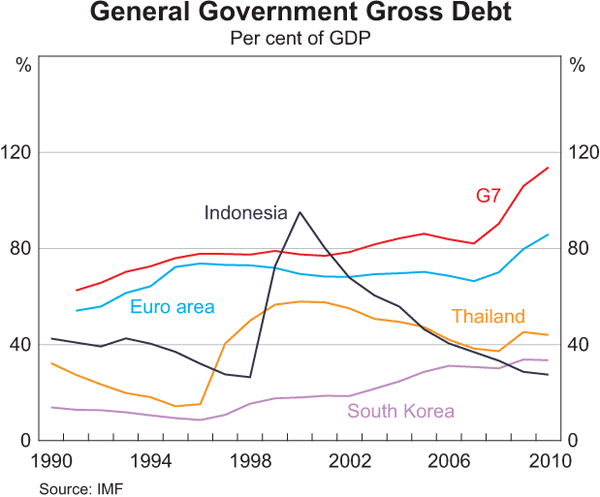
Conclusion
The Indonesian economy has recorded relatively strong average growth over a number of decades. Considerable structural change has taken place over this time, with Indonesia becoming increasingly industrialised and integrated into the global economy. With plans for substantial infrastructure spending over the next several years and favourable demographics, the Indonesian economy is widely expected to continue to grow at a strong pace over the next decade. Nevertheless, as elsewhere in the emerging world, policy implementation will be a key challenge in realising the country's growth plans.
Footnotes
The authors are from Economic Analysis Department. [*]
Unless otherwise specified, east Asia refers to the economies of China, South Korea, Taiwan, Hong Kong, Singapore, Indonesia, Thailand, Malaysia and the Philippines. [1]
In this article the agricultural sector is defined to include forestry, fishing and hunting. [2]
As explored in Hall and Stone (2010), this boost is expected to fade gradually with demographic factors starting to drag on growth in the late 2020s. [3]
For example, in the East Nusa Tenggara and Maluku provinces, per capita GDP is just a fifth of the Indonesian average and one-sixteenth the size of per capita GDP in Jakarta. [4]
Australia and Indonesia's coal production differs in composition; partly reflecting this, Indonesia predominately exports thermal coal, whereas thermal coal makes up only around half of Australia's coal exports (by volume). [5]
Component trade is a significant portion of Indonesia's exports to east Asian economies even though Indonesia is not as heavily integrated into regional supply chains as most other economies in the region. [6]
As a share of real GDP, investment is only moderately above its post-Asian crisis lows. [7]
References
Arze del Granado FJ, W Fengler, A Ragatz and E Yavuz (2007), ‘Investing in Indonesia's Education: Allocation, Equity, and Efficiency of Public Expenditures’, World Bank Policy Research Working Paper No 4329.
ADB (Asian Development Bank), International Labour Organization (ILO) and Islamic Development Bank (IDB) (2010), Indonesia: Critical Development Constraints, Asian Development Bank, Philippines.
BP (2011), ‘BP Statistical Review of World Energy June 2011’.
Available at <http://www.bp.com/assets/bp_internet/globalbp/globalbp_uk_english/reports_and_publications/
statistical_energy_review_2011/STAGING/local_assets/pdf/statistical_review_of_world_energy_full_report_2011.pdf>.
Coordinating Ministry for Economic Affairs (2011), ‘Masterplan for Acceleration and Expansion of Indonesia Economic Development 2011–2025’, May.
Craig A, S Elias and C Noone (2011), ‘Destinations and Uses of East Asian Merchandise Exports’, RBA Bulletin, June, pp 9–14.
de Mello F (2008), ‘Indonesia: Growth Performance and Policy Challenges’, OECD Economics Department Working Paper No 637.
DFAT (Department of Foreign Affairs and Trade) (2011), ‘ASEAN-Australia-New Zealand FTA: Indonesia Entry into Force’, November. Available at <http://www.dfat.gov.au/fta/aanzfta/AANZFTA-Indonesia-entry-into-force.pdf>.
Goeltom MS (2007), ‘Economic and Fiscal Reforms: The Experience of Indonesia,
1980–1996’,
Essays in Macroeconomic Policy:
The Indonesian Experience, PT Gramedia
Pustaka, Jakarta,
pp 489–506.
Hall J and A Stone (2010), ‘Demography and Growth’, RBA Bulletin, June, pp 15–23.
Heston A, R Summers and B Aten (2006), Penn World Table Version 7.0, Center for International Comparisons of Production, Income and Prices at the University of Pennsylvania, May 2011.
National Development Planning Agency (2010), ‘National Medium-Term Development Plan 2010–2014’, February.
World Bank (2011), ‘Current Challenges, Future Potential’, Indonesia Economic Quarterly, June. Available at <http://siteresources.worldbank.org/INTINDONESIA/Resources/Publication/280016-1309148084759/IEQ-Jun2011-ENG-25June2011.pdf>.
World Economic Forum (2011), ‘The Global Competitiveness Report 2011–2012’. Available at <http://www3.weforum.org/docs/WEF_GCR_Report_2011-12.pdf>.